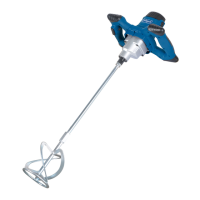www.scheppach.com / service@scheppach.com / +(49)-08223-4002-99 / +(49)-08223-4002-58
GB
|
19
Remove the mixing paddle from the drive shaft by
turning it anticlockwise. The paddle may sit quite
-
ture must be secured with a key against turning with
m Warning!
Disconnect the machine from the power supply be-
fore assembling or disassembling the stirrer.
possibly serious injury.
9. Operation
Turning on (Fig. 1)
Press and hold the circuit breaker (5) for the ON /
(4) to start the handheld mixer. Once the tool is run-
Speed controller (Fig. 5)
With the speed controller (6), the power tool’s speed
can be gradually adjusted. The type of material to be
mixed determines the speed rate that is required.
Practice will teach you the optimal speed required
by the respective material.
10. Cleaning and Maintenance
ATTENTION!
Unplug the power plug from the electrical outlet
before starting any work on the power tool.
Cleaning
• Keep the air vents of the machine clean in order to
prevent overheating.
• Clean the machine’s casing regularly with a soft
cloth, preferably after each use.
• Keep the air vents free from dust and dirt.
• If the dirt cannot be removed easily, use a cloth
that is moistened with soapy water.
ATTENTION!
Do not use solvents such as benzene, alcohol,
ammonia solutions, etc. These solvents may
damage the plastic parts.
7. Technical data
Nominal voltage 220-240 V~ 50 Hz
Power consumption 1200 Watt
Speed 0-700 min
-1
Weight 4.8 kg
M14
Stirrer diameter 140 mm
Sound emission
Noise emission values are measured according to
the relevant standards.
Sound pressure level L
pA
89 dB(A)
Uncertainty K 3 dB(A)
Sound power level L
wA
100 dB(A)
Uncertainty K 3 dB(A)
Vibration a
h
5.67 m/s²
Uncertainty K 1.5 m/s²
• The indicated vibration emission value has been
measured using a standardized test procedure and
can be used to compare one electric tool with an-
other;
• The indicated vibration emission value can also
be used in a preliminary exposure assessment.
• Depending on how the power tool is used, the vi-
-
• Try to keep the exposure to vibrations as low as
possible. Actions reducing the exposure to vibra-
tion include, for example, wearing gloves when the
tool is used and limiting the working time. Here, all
aspects of the operating cycle must be considered
and those when the tool is turned on but running
without load).
8. Assembly
1. Thread the mixing paddle (1) clockwise into the
2. Drive the assembled mixing paddle onto the drive
DANGER!
Use only a mixing paddle that is designed and
suitable for the material to be mixed. A wrong
mixing paddle may put strain on the power tool
which may damage the tool and lead to acci-
dents!

